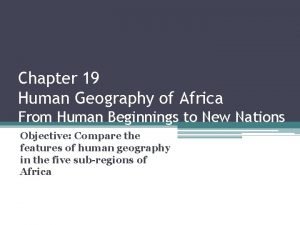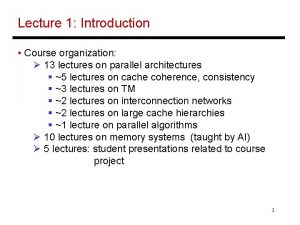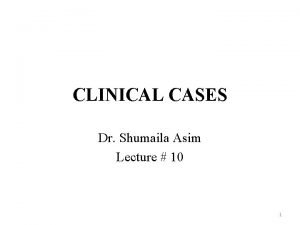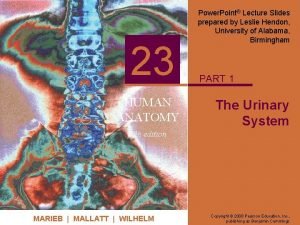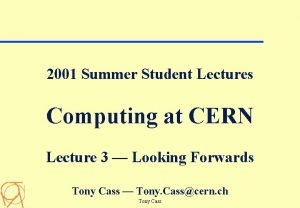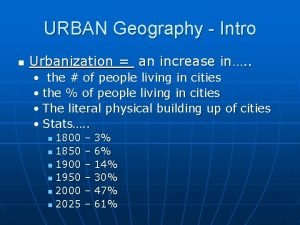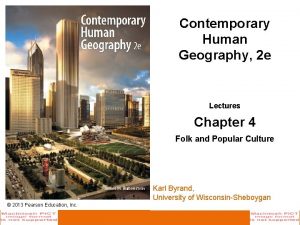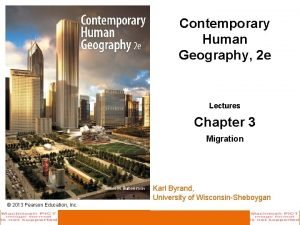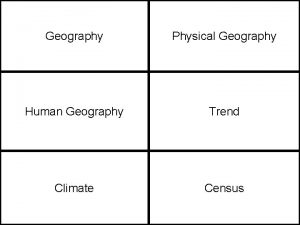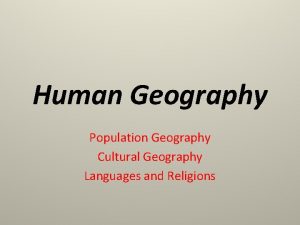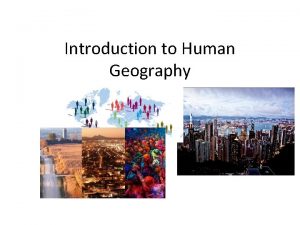Contemporary Human Geography 2 e Lectures Chapter 2





















































































- Slides: 85

Contemporary Human Geography, 2 e Lectures Chapter 2 Population Karl Byrand, University of Wisconsin-Sheboygan © 2013 Pearson Education, Inc.

2. 1 Population Concentrations • Sparsely populated regions • Humans avoid clustering in certain physical environments. – Dry lands – Cold lands – Mountainous lands – Lands that are too wet © 2013 Pearson Education, Inc.

2. 1 Population Concentrations FOUR POPULATION CLUSTERS © 2013 Pearson Education, Inc.

2. 1 Population Concentrations • Heavily populated regions • Two-thirds of the world’s inhabitants are clustered in four regions. – East Asia, Southeast Asia, Western Europe © 2013 Pearson Education, Inc.

2. 1 Population Concentrations POPULATION CARTOGRAM © 2013 Pearson Education, Inc.

2. 2 Population Density • Density – The number of people occupying an area of land • Arithmetic density – Total number of persons/total land area • AKA population density © 2013 Pearson Education, Inc.

2. 2 Population Density ARITHMETIC DENSITY © 2013 Pearson Education, Inc.

2. 2 Population Density ARITHMETIC DENSITY OF FOUR COUNTRIES © 2013 Pearson Education, Inc.

2. 2 Population Density • Physiological density – Total number of people supported by a unit of arable (farmable) land © 2013 Pearson Education, Inc.

2. 2 Population Density PHYSIOLOGICAL DENSITY © 2013 Pearson Education, Inc.

2. 2 Population Density PHYSIOLOGICAL DENSITY OF FOUR COUNTRIES © 2013 Pearson Education, Inc.

2. 2 Population Density • Agricultural density – Ratio of the number of farmers to the amount of arable land © 2013 Pearson Education, Inc.

2. 2 Population Density AGRICULTURAL DENSITY © 2013 Pearson Education, Inc.

2. 2 Population Density AGRICULTURAL DENSITY OF FOUR COUNTRIES © 2013 Pearson Education, Inc.

2. 3 Components of Change • Measures of population change • Natural Increase Rate (NIR) – Percentage by which a population grows in a year – Only uses birth and death rates – Immigration and emigration are excluded © 2013 Pearson Education, Inc.

2. 3 Components of Change NATURAL INCREASE RATE © 2013 Pearson Education, Inc.

2. 3 Components of Change • Doubling time – Number of years needed to double a population © 2013 Pearson Education, Inc.

2. 3 Components of Change WORLD POPULATION GROWTH © 2013 Pearson Education, Inc.

2. 3 Components of Change • Crude Birth Rate (CBR) – Total number of live births/year/1, 000 people in a society © 2013 Pearson Education, Inc.

2. 3 Components of Change CRUDE BIRTH RATE © 2013 Pearson Education, Inc.

2. 3 Components of Change • Crude Death Rate (CDR) – Total number of deaths/year/1, 000 people in a society © 2013 Pearson Education, Inc.

2. 3 Components of Change CRUDE DEATH RATE © 2013 Pearson Education, Inc.

2. 3 Components of Change • NIR = CBR – CDR/10 © 2013 Pearson Education, Inc.

2. 4 Population Structure • Total Fertility Rate (TFR) – Average number of children a woman will have throughout her childbearing years • Behavior predictor © 2013 Pearson Education, Inc.

2. 4 Population Structure TOTAL FERTILITY RATE © 2013 Pearson Education, Inc.

2. 4 Population Structure • Infant Mortality Rate (IMR) – Annual number of deaths of infants under 1 year of age, compared with live births • Health care access indicator © 2013 Pearson Education, Inc.

2. 4 Population Structure INFANT MORTALITY RATE © 2013 Pearson Education, Inc.

2. 4 Population Structure • Life expectancy – Number of years a newborn infant can expect to live, assuming current mortality levels • Health care access and wealth indicator © 2013 Pearson Education, Inc.

2. 4 Population Structure LIFE EXPECTANCY AT BIRTH © 2013 Pearson Education, Inc.

2. 4 Population Structure • Young and old – Dependency ratio • Number of people who are too young or too old to work, compared to the number of people in their productive years • Indicates financial burden on a society’s productive population © 2013 Pearson Education, Inc.

2. 4 Population Structure POPULATION UNDER AGE 15 © 2013 Pearson Education, Inc.

2. 4 Population Structure • Population pyramid – Displays a country’s population by age and gender © 2013 Pearson Education, Inc.

2. 4 Population Structure POPULATION PYRAMID OF THE UNITED STATES © 2013 Pearson Education, Inc.

2. 5 The Demographic Transition • Demographic transition – Process of change in a country’s population – Every country is in one of the four stages of the demographic transition © 2013 Pearson Education, Inc.

2. 5 The Demographic Transition DEMOGRAPHIC TRANSITION © 2013 Pearson Education, Inc.

2. 5 The Demographic Transition • Stage 1 – Very high CBR – Very high CDR – Very low NIR © 2013 Pearson Education, Inc.

2. 5 The Demographic Transition DEMOGRAPHIC TRANSITION © 2013 Pearson Education, Inc.

2. 5 The Demographic Transition • Stage 2 – High CBR – Rapidly declining CDR – Very high NIR © 2013 Pearson Education, Inc.

2. 5 The Demographic Transition DEMOGRAPHIC TRANSITION © 2013 Pearson Education, Inc.

2. 5 The Demographic Transition • Stage 3 – Rapidly declining CBR – Moderately declining CDR – Moderate NIR © 2013 Pearson Education, Inc.

2. 5 The Demographic Transition DEMOGRAPHIC TRANSITION © 2013 Pearson Education, Inc.

2. 5 The Demographic Transition • Stage 4 – Very low CBR – Low, slightly increasing CDR – Zero or negative NIR © 2013 Pearson Education, Inc.

2. 5 The Demographic Transition DEMOGRAPHIC TRANSITION © 2013 Pearson Education, Inc.

2. 5 The Demographic Transition POPULATION PYRAMID AND DEMOGRAPHIC TRANSITION FOR CAPE VERDE (LEFT), CHILE (CENTER), DENMARK (RIGHT) © 2013 Pearson Education, Inc.

2. 6 Declining Birth Rates • Population has been increasing at a slower rate since the mid-twentieth century. – Decline is mostly due to lower birth rates. © 2013 Pearson Education, Inc.

2. 6 Declining Birth Rates CRUDE BIRTH RATE CHANGE 1980– 2010 © 2013 Pearson Education, Inc.

2. 6 Declining Birth Rates • Two population reduction strategies: – 1. Education and health care – 2. Distribution of contraceptives © 2013 Pearson Education, Inc.

2. 6 Declining Birth Rates • Lowering birth rates through education and health care – Improvement of economic conditions is key. • Wealthier communities have more to spend on education and health care. • More educated women have greater economic control over their lives. • More educated women better understand their reproductive rights, make more informed choices, and select more effective contraception. • Better health care leads to lower IMRs. • Lower IMRs lead to higher likelihood of contraception use. © 2013 Pearson Education, Inc.

2. 6 Declining Birth Rates • Lowering birth rates through contraception – Rapidly, cheaply, and widely distributed contraception • A more rapid method than economic development • Family-planning programs can be used as well. © 2013 Pearson Education, Inc.

2. 6 Declining Birth Rates • Problematic regions: – Bangladesh • Low levels of wealth and literacy © 2013 Pearson Education, Inc.

2. 6 Declining Birth Rates WOMEN USING FAMILY PLANNING © 2013 Pearson Education, Inc.

2. 6 Declining Birth Rates • Problematic regions: – Africa • Economics, religion, and low levels of education limit contraception use. © 2013 Pearson Education, Inc.

2. 6 Declining Birth Rates WOMEN USING FAMILY PLANNING © 2013 Pearson Education, Inc.

2. 6 Declining Birth Rates FAMILY PLANNING METHODS © 2013 Pearson Education, Inc.

2. 6 Declining Birth Rates • Problematic regions: – Southwestern Asia • Low status of women limits contraception use. – Women have less access to education and hold fewer legal rights as compared to men. – Large families—male symbol of virility © 2013 Pearson Education, Inc.

2. 6 Declining Birth Rates WOMEN USING FAMILY PLANNING © 2013 Pearson Education, Inc.

2. 7 Population Futures • World population will still increase, but at a slower rate than in the past. • Components of future population growth – Fertility is the primary determinant. © 2013 Pearson Education, Inc.

2. 7 Population Futures FUTURE POPULATION GROWTH © 2013 Pearson Education, Inc.

2. 7 Population Futures • Elderly Support Ratio – The number of working-age people (ages 15– 64) divided by the number of persons 65 or older © 2013 Pearson Education, Inc.

2. 7 Population Futures ELDERLY SUPPORT RATIO © 2013 Pearson Education, Inc.

2. 7 Population Futures • Demographic transition possible stage 5 • Many developed countries are predicted to experience population decline. – Factor of more elderly than young population in these countries – Fewer young women who will be entering their childbearing years © 2013 Pearson Education, Inc.

2. 7 Population Futures POSSIBLE STAGE 5 OF DEMOGRAPHIC TRANSITION © 2013 Pearson Education, Inc.

2. 7 Population Futures POSTER IN SHANGHAI, CHINA, PROMOTES ONE-CHILD POLICY © 2013 Pearson Education, Inc.

2. 7 Population Futures • India Versus China • These two countries comprise more than one -third of the world’s population. • India’s population policies – Beginning in 1971, citizens paid to be sterilized – Now a stronger emphasis on education as family planning – Limited success © 2013 Pearson Education, Inc.

2. 7 Population Futures • India Versus China • China’s population policies – Beginning in 1980, one-child policy – Financial and other incentives to limit family size – Greater prosperity in China has led to a relaxation of one-child policy – Now a stronger emphasis on education as family planning • Family-planning fees © 2013 Pearson Education, Inc.

2. 8 Malthus’s Grim Forecast • Thomas Malthus (1766– 1834) – An Essay on the Principle of Population, 1798 – Population increases geometrically – Food production increases arithmetically © 2013 Pearson Education, Inc.

2. 8 Malthus’s Grim Forecast MALTHUS THEORY AND REALITY © 2013 Pearson Education, Inc.

2. 8 Malthus’s Grim Forecast • Contemporary Malthus supporters observe that today: – Relatively poor countries have experienced the most rapid population growth. • Little wealth in these countries to support growth – World population growth is outstripping many global resources. • Will result in war and other civil violence © 2013 Pearson Education, Inc.

2. 8 Malthus’s Grim Forecast • Malthus’s Critics – Argue a larger population could stimulate economic growth, food production, and technological development. – Unjust social practices are to blame, not lack of resources. – Some argue that high population growth leads to greater political and economic power. © 2013 Pearson Education, Inc.

2. 8 Malthus’s Grim Forecast • Malthus’s theory and reality – Globally, Malthus’s theory has not been supported during the past 50 years. • World food production has increased faster than the NIR. – Hunger and famine are distribution problems and not production problems. – Cultural, economic, and technological change has slowed population growth. © 2013 Pearson Education, Inc.

2. 9 The Epidemiological Transition • Each stage of the demographic transition has distinctive causes of death. • The leading causes of death shift through the demographic transition. © 2013 Pearson Education, Inc.

2. 9 The Epidemiological Transition • Stage 1: Pestilence and famine (high CDR) – “natural checks” • Infectious and parasitic diseases, accidents, animal and human attacks © 2013 Pearson Education, Inc.

2. 9 The Epidemiological Transition • Stage 2: Receding pandemics (rapidly declining CDR) – Improved sanitation, nutrition, medicine, and industrial revolution – Not immediate decline in CDR © 2013 Pearson Education, Inc.

2. 9 The Epidemiological Transition • Stage 3: Degenerative diseases (moderately declining CDR) – Decreasing deaths from infectious diseases and increase in chronic disorders (aging) © 2013 Pearson Education, Inc.

2. 9 The Epidemiological Transition • Stage 4: Delayed degenerative diseases (low but increasing CDR) – Cancer and cardiovascular diseases still present – Medical advances and behavioral changes extend life expectancy © 2013 Pearson Education, Inc.

2. 9 The Epidemiological Transition • Early mapped cholera distribution • John Snow – English doctor mapped location of 1854 Soho (London, UK) cholera victims and location of water pumps • Revealed that the disease was caused by contaminated water © 2013 Pearson Education, Inc.

2. 9 The Epidemiological Transition BIRTH OF GIS © 2013 Pearson Education, Inc.

2. 10 Global Health Threats • Some infectious diseases have returned, and new ones have emerged. – A possible Stage 5 of the epidemiological transition – Previously controlled and eradicated diseases return – New diseases emerge © 2013 Pearson Education, Inc.

2. 10 Global Health Threats • Reasons for possible Stage 5 – Poverty • Unsanitary conditions and poor access to medical care © 2013 Pearson Education, Inc.

2. 10 Global Health Threats TUBERCULOSIS (TB) DEATHS, 2009 © 2013 Pearson Education, Inc.

2. 10 Global Health Threats • Reasons for possible Stage 5 – Evolution • Development of resistance to drugs and other controls – Improved travel • More rapid and widespread transportation of diseases © 2013 Pearson Education, Inc.

2. 10 Global Health Threats INTERNATIONAL PASSENGER ARRIVALS © 2013 Pearson Education, Inc.

2. 10 Global Health Threats DIFFUSION OF AIDS IN THE UNITED STATES © 2013 Pearson Education, Inc.

2. 10 Global Health Threats HIV/AIDS © 2013 Pearson Education, Inc.

Chapter Review • Key Questions – Where is the world’s population distributed? – Why does population growth vary among countries? – How might population change in the future? © 2013 Pearson Education, Inc.
 Ap human geography frqs
Ap human geography frqs 5 themes of geography ap human geography
5 themes of geography ap human geography Ap human geography political geography test
Ap human geography political geography test Gni definition ap human geography
Gni definition ap human geography Ap human geography chapter 11 vocab
Ap human geography chapter 11 vocab Chapter 16 section 1 russia and the western republics
Chapter 16 section 1 russia and the western republics Chapter 22 human geography of southwest asia
Chapter 22 human geography of southwest asia Chapter 11 ap human geography
Chapter 11 ap human geography Chapter 7 lesson 2 social studies
Chapter 7 lesson 2 social studies Chapter 5 ap human geography
Chapter 5 ap human geography Chapter 13 human geography of europe
Chapter 13 human geography of europe Chapter 5 key issue 1 ap human geography
Chapter 5 key issue 1 ap human geography Why is the united states called a postindustrial economy
Why is the united states called a postindustrial economy Chapter 25 human geography of south asia
Chapter 25 human geography of south asia Chapter 19 human geography of africa
Chapter 19 human geography of africa Rick trebino lectures
Rick trebino lectures Lectures paediatrics
Lectures paediatrics Data mining lectures
Data mining lectures Medicinal chemistry lectures
Medicinal chemistry lectures Uva powerpoint template
Uva powerpoint template Ludic space
Ludic space Planning a software project
Planning a software project Cell and molecular biology lectures
Cell and molecular biology lectures Radio astronomy lectures
Radio astronomy lectures Dr sohail lectures
Dr sohail lectures Utilities and energy lecture
Utilities and energy lecture Introduction to web engineering
Introduction to web engineering How to get the most out of lectures
How to get the most out of lectures Frcr physics lectures
Frcr physics lectures Frequency of xrays
Frequency of xrays Introduction to recursion
Introduction to recursion Rbc formation stages
Rbc formation stages Aerodynamics lectures
Aerodynamics lectures Theory of translation lectures
Theory of translation lectures Power system lectures
Power system lectures Theory and practice of translation lectures
Theory and practice of translation lectures Translation 1
Translation 1 Digital logic design lectures
Digital logic design lectures Jim kurose gaia
Jim kurose gaia Hegel classical art
Hegel classical art Nuclear medicine lectures
Nuclear medicine lectures Recursive fractals c++
Recursive fractals c++ Cdeep lectures
Cdeep lectures Oral communication 3 lectures text
Oral communication 3 lectures text C programming and numerical analysis an introduction
C programming and numerical analysis an introduction Haematology lectures
Haematology lectures Bureau of lectures
Bureau of lectures Trend lectures
Trend lectures Theory of translation lectures
Theory of translation lectures Reinforcement learning lectures
Reinforcement learning lectures 13 lectures
13 lectures Reinforcement learning lectures
Reinforcement learning lectures Bba lectures
Bba lectures Medical emergency student lectures
Medical emergency student lectures Hematology medical student lectures
Hematology medical student lectures Stratog online lectures
Stratog online lectures Bhadeshia lectures
Bhadeshia lectures Ota resident lectures
Ota resident lectures Comsats virtual campus lectures
Comsats virtual campus lectures Hugh blair lectures on rhetoric
Hugh blair lectures on rhetoric Cern summer student lectures
Cern summer student lectures Pathology lectures for medical students
Pathology lectures for medical students Dr asim lectures
Dr asim lectures Ota resident lectures
Ota resident lectures Anatomy lectures powerpoint
Anatomy lectures powerpoint Cern summer school lectures
Cern summer school lectures 8.3 human needs
8.3 human needs Chapter 8 human needs and human development
Chapter 8 human needs and human development Brownfields ap human geography
Brownfields ap human geography What is contour lines in geography
What is contour lines in geography Alpha beta gamma cities ap human geography
Alpha beta gamma cities ap human geography Anocracy ap human geography definition
Anocracy ap human geography definition Weber's least cost theory ap human geography
Weber's least cost theory ap human geography Von thunen
Von thunen Township and range ap human geography
Township and range ap human geography Ranching definition ap human geography
Ranching definition ap human geography Township and range aphg
Township and range aphg Suburban sprawl definition ap human geography
Suburban sprawl definition ap human geography Second urban revolution ap human geography
Second urban revolution ap human geography Central place theory assumptions
Central place theory assumptions Technopole ap human geography
Technopole ap human geography Modernization model ap human geography
Modernization model ap human geography Nation state
Nation state Geographic grid
Geographic grid Bid rent theory
Bid rent theory Geri flanary
Geri flanary














